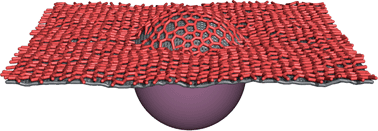Membrane indentation triggers clathrin lattice reorganization and fluidization
Abstract
Clathrin-mediated endocytosis involves the coordinated assembly of clathrin cages around membrane indentations, necessitating fluid-like reorganization followed by solid-like stabilization. This apparent duality in clathrin's in vivo behavior provides some indication that the physical interactions between clathrin triskelia and the membrane effect a local response that triggers fluid–solid transformations within the clathrin lattice. We develop a computational model to study the response of clathrin protein lattices to spherical deformations of the underlying flexible membrane. These deformations are similar to the shapes assumed during intracellular trafficking of nanoparticles. Through Monte Carlo simulations of clathrin-on-membrane systems, we observe that these membrane indentations give rise to a greater than normal defect density within the overlaid clathrin lattice. In many cases, the bulk surrounding lattice remains in a crystalline phase, and the extra defects are localized to the regions of large curvature. This can be explained by the fact that the in-plane elastic stress in the clathrin lattice are reduced by coupling defects to highly curved regions. The presence of defects brought about by indentation can result in the fluidization of a lattice that would otherwise be crystalline, resulting in an indentation-driven, defect-mediated phase transition. Altering subunit elasticity or membrane properties is shown to drive a similar transition, and we present phase diagrams that map out the combined effects of these parameters on clathrin lattice properties.


 Please wait while we load your content...
Please wait while we load your content...